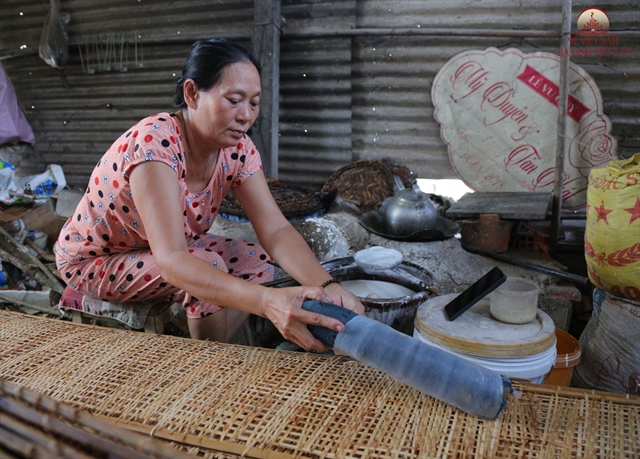 |
| A craftwoman makes rice paper using a tube and boiled rice powder. — Photo tcdulichtphcm.vn |
HÀ NỘI — Traditional crafts struggle to survive in many communities in Việt Nam, as young people seek job opportunities elsewhere.
The decline can be observed in Vĩnh Phú Đông Commune in Phước Long District in the southern province of Bạc Liêu, which once had a flourishing mat weaving industry involving more than 500 families.
The increasing competition from mass-produced mats has slashed income, driving many young people to abandon the craft and pursue other avenues. Only 90 families in the commune continue to practise mat weaving today.
"Even the most skilled mat weavers can earn merely VNĐ80,000 (about US$3) daily," said Trương Thị Liễu, a seasoned weaver with two decades of experience.
"Due to increasing competition, it has become challenging to sell our products, prompting young weavers to leave the trade and migrate to cities for work."
Nguyễn Thị Chín, another weaver with five decades of experience, expressed her concern about the craft's future as her children show little interest in centuries-old mat-weaving techniques.
"I fear my children will not carry on this tradition when I am too old to weave. Most mat weavers today are elderly, while young people seek higher-paying factory jobs," said Chín.
The situation is no better in Phú Hòa Đông Commune in HCM City's Củ Chi District, where a rice paper-making craft, once a local pride, has seen the participation of just 10 families.
Bùi Thanh Long, whose mother was a rice paper maker, shared that he and his sister took over the family business after their mother passed away twenty years ago. But because the once-lucrative craft could not keep pace with the rising cost of living, they jumped ship.
"The income was never substantial, and as the years went by, it became increasingly difficult to make ends meet. Eventually, my sister had to find a job in a factory, and I turned to trading," said Long.
The rice paper-making process is highly dependent on weather conditions, and any unexpected changes can severely impact production.
Additionally, the market price for handmade rice paper has remained relatively low, making craftmen difficult to earn a decent income. As a result, many have been forced to abandon the craft in favour of more lucrative opportunities.
Nguyễn Hồng Linh has been making rice paper for nearly four decades. Despite her deep-rooted connection to the craft, she does not want her children to follow in her footsteps.
"This job is incredibly demanding. I start as early as 2am and work until 4pm, only to earn about VNĐ150,000 (approximately $6) daily," said Linh.
Hoàng Ngọc Thái, a young man in Phú Đô Village in Nam Từ Liêm District in Hà Nội, shared that while his family has been making noodles for generations, he had chosen a different career path for better income.
"Making noodles is demanding, yet the pay is not great. With the rise of mass-produced noodles, it's becoming increasingly difficult for producers with traditional techniques to withstand the competition," said Thái.
Phú Đô noodles are renowned for their high quality and unique flavour, but the production process is labour-intensive and time-consuming. A worker takes about two days to produce a batch of noodles, only to earn about VNĐ10,000 (about 40 cents) per kilo.
"It’s part of our routine to wake up before dawn to make sure we can deliver fresh noodles to our customers," said Nguyễn Thị Tâm, a 50-year-old producer.
According to Nguyễn Trường Giang, deputy head of the Anthropology Department at the University of Social Sciences and Humanities, one of the biggest challenges facing traditional crafts is the lack of appeal to young generations.
While traditional crafts offer a deep connection to cultural heritage, they often struggle to keep up with changing consumer tastes.
"Traditional products, while steeped in history, may lack the novelty and modernity that today's consumers, especially young people, seek," said Giang.
Furthermore, the income generated from traditional crafts is often unstable and lower than what can be earned in other industries. This economic disparity has driven many young people to seek jobs in more lucrative sectors.
He suggests traditional craftsmen adopt a more innovative mindset, creating products that cater to modern tastes while preserving traditional techniques.
Leveraging technology for marketing and promotion is also crucial. Social media and online platforms can help reach a wider audience and connect with consumers who appreciate the value of handcrafted goods.
Organising workshops to share experiences and encourage young people to learn about traditional crafts could also help foster a new generation of craftsmen and enthusiasts. — VNS
























